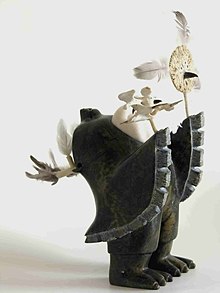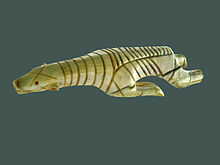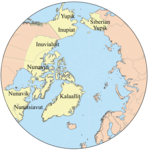
Pitseolak Ashoona was an Inuk Canadian artist admired for her prolific body of work. She was also a member of the Royal Canadian Academy of Arts.
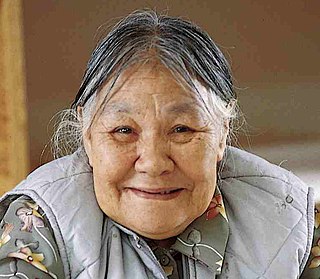
Kenojuak Ashevak,, is celebrated as a leading figure of modern Inuit art.

Kinngait, known as Cape Dorset until 27 February 2020, is an Inuit hamlet located on Dorset Island near Foxe Peninsula at the southern tip of Baffin Island in the Qikiqtaaluk Region of Nunavut, Canada.

Peter Pitseolak (1902–1973) was an Inuk photographer, sculptor, artist and historian. Pitseolak was Baffin Island's first indigenous photographer.

Annie Pootoogook was a Canadian Inuk artist known for her pen and coloured pencil drawings. In her art, Pootoogook often portrayed the experiences of those in her community of Kinngait, in northern Canada, and memories and events from her own life.

Pudlo Pudlat, was a Canadian Inuit artist whose preferred medium was a combination of acrylic wash and coloured pencils. His works are in the collections of most Canadian museums. At his death in 1992, Pudlo left a body of work that included more than 4000 drawings and 200 prints.

Kananginak Pootoogook was an Inuk sculptor and printmaker who lived in Cape Dorset, Nunavut, in Canada. He died as a result of complications related to surgery for lung cancer.

Shuvinai Ashoona is an Inuk artist who works primarily in drawing. She is known for her detailed pen and pencil drawings depicting northern landscapes and contemporary Inuit life.
Pitaloosie Saila was a Canadian Inuk graphic artist who predominantly made drawings and lithograph prints. Saila's work often explores themes such as family, shamanism, birds, and her personal life experiences as an Inuk woman. Her work has been displayed in over 150 exhibitions nationally and internationally, such as in the acclaimed Isumavut exhibition called "The Artistic Expression of Nine Cape Dorset Women". In 2004, Pitaloosie Saila and her well-known husband and sculptor Pauta Saila were both inducted into the Royal Canadian Academy of Arts.
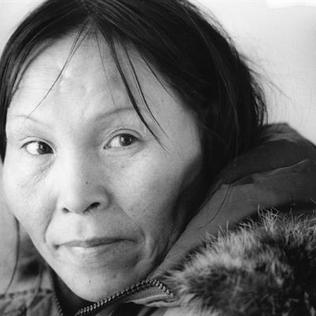
Napachie Pootoogook was a Canadian Inuit graphic artist.

Ovilu (Oviloo) Tunnillie was born at Kangia, Baffin Island, Northwest Territories and was an Inuit sculptor. Her carvings served as her commentary on both traditional and changing contemporary Inuit culture. She was one of the first Inuit artists to work with an autobiographical theme.
Alashua Aningmiuq (1914–1972) was an Inuit graphic artist and a carver in Nunavut, Canada working in the 1950s and 1960s.
Kiugak Ashoona was a Canadian Inuk artist renowned for his sculptural work and his expansive artistic portfolio. He experienced the longest career of any Cape Dorset artist, and is a member of the Order of Canada and the Royal Canadian Academy of Arts. In 1999, he was awarded the Canada Council Molson Prize for his outstanding lifetime contribution to the cultural and intellectual life of Canada.
Siassie Kenneally was an Inuk artist based in Cape Dorset (Kinngait), Northwest Territories. Kenneally was known for her pencil-crayon drawings depicting traditional Inuit lifestyles.
The West Baffin Eskimo Cooperative, also known as the Kinngait Co-operative is an Inuit co-operative in Kinngait, Nunavut best known for its activities in buying, producing and selling Inuit artworks. The co-operative is part of Arctic Co-operatives Limited, a group of locally owned businesses that provide fundamental services in the Canadian north. The co-operative sets prices for the sale of its member's works, pays the artists in advance and shares its profits with its members.

Kiakshuk was a Canadian Inuit artist who worked both in sculpture and printmaking. Kiakshuk began printmaking in his seventies and, is most commonly praised for creating “real Eskimo pictures” that relate traditional Inuit life and mythology.
Nicotye Samayualie is a Canadian Inuk artist from Cape Dorset, Nunavut. Samayualie specializes in drawings of still lifes and landscapes. She often uses large-format drawings to create expansive images of Cape Dorset landscapes.
Sharni Pootoogook (1922–2003) was an Inuit printmaker from Cape Dorset, Nunavut.
Eegyvudluk Pootoogook (1931-2000) was an Inuk printmaker and sculptor. He was married to the artist Napachie Pootoogook.
Toonoo Tunnillie (1920–1969) was an Inuit artist and the father of notable artist Oviloo Tunnillie.
